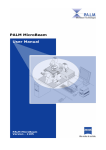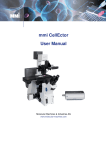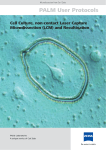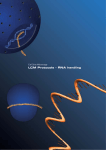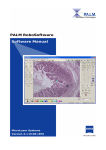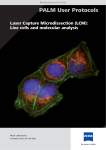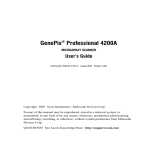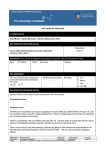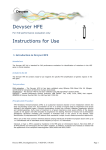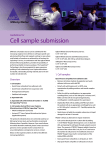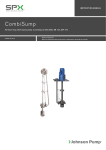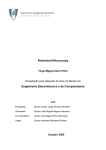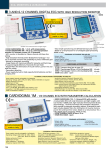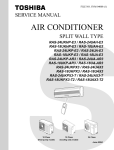Download PALM MicroBeam January 2008 User Manual
Transcript
PALM MicroBeam January 2008 User Manual This document is supplied only to persons who are trained and authorized by Carl Zeiss MicroImaging GmbH. No part of this document may be reproduced or distributed in any form or by any means without the prior written consent of Carl Zeiss MicroImaging GmbH. The information in this document is subject to change without notice. Carl Zeiss MicroImaging GmbH assumes no responsibility for any errors that may appear. Printed January 2008 Eight edition Regulatory Notice: PALM MicroLaser Systems are intended for research use only and are not approved for medical applications in all countries. Published by: Carl Zeiss MicroImaging GmbH Location: Bernried Am Neuland 9+12 82347 Bernried / Germany Phone: +49-(0)8158-9971-0 Fax: +49-(0)8158-9971-249 E-mail: [email protected] www.zeiss.de/microdissection ©Carl Zeiss MicroImaging GmbH, 2008. All rights reserved. 2 PALM MicroBeam User Manual - 0108 List of Contents Contents Chapter Page 1 1.1 1.2 1.3 1.4 Important Basic Information . . . . . . . . . . . . . . Intended use of PALM MicroLaser Systems . . . . . . Legal notes . . . . . . . . . . . . . . . . . . . . . . . . . . . . Conventions for User Manual . . . . . . . . . . . . . . . . How to contact us. . . . . . . . . . . . . . . . . . . . . . . . 2 Installation . . . . . . . . . . . . . . . . . . . . . . . . . . . . . . . . . . . . . . . . . . . . . . . . . . . . . . . . . . . . . 7 3 3.1 3.2 3.3 Operating Room . . . . . . . . . . . . . . . . . . . . . . . . General . . . . . . . . . . . . . . . . . . . . . . . . . . . . . . . Admissible ambient conditions . . . . . . . . . . . . . . . Making power connection . . . . . . . . . . . . . . . . . . 4 4.1 4.2 4.3 4.4 4.5 4.6 4.7 Safety . . . . . . . . . . . . . . . . . . . . . . . . . . . . . . . . . . . . . . . . . . . . . . . . . . . . . . . . . . . . . . . . 10 What you should do in the event of a fault. . . . . . . . . . . . . . . . . . . . . . . . . . . . . . . . . . . . . . 10 Observe User Manual . . . . . . . . . . . . . . . . . . . . . . . . . . . . . . . . . . . . . . . . . . . . . . . . . . . . 10 Laser safety . . . . . . . . . . . . . . . . . . . . . . . . . . . . . . . . . . . . . . . . . . . . . . . . . . . . . . . . . . . 10 Safety markings and type plate . . . . . . . . . . . . . . . . . . . . . . . . . . . . . . . . . . . . . . . . . . . . . 11 Staff qualifications . . . . . . . . . . . . . . . . . . . . . . . . . . . . . . . . . . . . . . . . . . . . . . . . . . . . . . 14 Points requiring strict compliance . . . . . . . . . . . . . . . . . . . . . . . . . . . . . . . . . . . . . . . . . . . . 14 Consideration of further risks and preventive measures . . . . . . . . . . . . . . . . . . . . . . . . . . . . 14 4.7.1 Further risks and protective measures – laser . . . . . . . . . . . . . . . . . . . . . . . . . . . . . . 14 4.7.2 Further risks – electricity . . . . . . . . . . . . . . . . . . . . . . . . . . . . . . . . . . . . . . . . . . . . . 15 4.7.3 Further risks – infectious material . . . . . . . . . . . . . . . . . . . . . . . . . . . . . . . . . . . . . . . 15 4.7.4 Further risks – EMC . . . . . . . . . . . . . . . . . . . . . . . . . . . . . . . . . . . . . . . . . . . . . . . . . 15 4.7.5 Further risks – extinguishing fire . . . . . . . . . . . . . . . . . . . . . . . . . . . . . . . . . . . . . . . . 15 4.7.6 Further risks – moving parts . . . . . . . . . . . . . . . . . . . . . . . . . . . . . . . . . . . . . . . . . . 15 Disposal . . . . . . . . . . . . . . . . . . . . . . . . . . . . . . . . . . . . . . . . . . . . . . . . . . . . . . . . . . . . . 16 4.8.1 Ensuring safe and ecological disposal . . . . . . . . . . . . . . . . . . . . . . . . . . . . . . . . . . . . 16 4.8.2 For EU states only . . . . . . . . . . . . . . . . . . . . . . . . . . . . . . . . . . . . . . . . . . . . . . . . . . 16 4.8 . . . . . . . . . . . . . . . . . . . . . . . . . . . . . . . . . . . . . . . . . . . . . ............................ ........................... ........................... ........................... ........................... ............................ ........................... ........................... ........................... 5 5.1 5.2 5.3 5.4 5.5 5.6 5.7 5.8 5.9 5.10 5.11 5.12 PALM MicroBeam - Overview . . . . . . . . . . . . . . . . . . . . . . . . . . . . . . . . . . . . . . . . . . . . . . PALM ControlUnit . . . . . . . . . . . . . . . . . . . . . . . . . . . . . . . . . . . . . . . . . . . . . . . . . . . . . . . LaserUnit . . . . . . . . . . . . . . . . . . . . . . . . . . . . . . . . . . . . . . . . . . . . . . . . . . . . . . . . . . . . . Microscope adapter . . . . . . . . . . . . . . . . . . . . . . . . . . . . . . . . . . . . . . . . . . . . . . . . . . . . . . Microscope Zeiss Axio Observer Z1; preparing for laser operation . . . . . . . . . . . . . . . . . . . . . Fluorescence attachment . . . . . . . . . . . . . . . . . . . . . . . . . . . . . . . . . . . . . . . . . . . . . . . . . . PALM Stage II . . . . . . . . . . . . . . . . . . . . . . . . . . . . . . . . . . . . . . . . . . . . . . . . . . . . . . . . . PALM CapMover II . . . . . . . . . . . . . . . . . . . . . . . . . . . . . . . . . . . . . . . . . . . . . . . . . . . . . . PALM RoboMover . . . . . . . . . . . . . . . . . . . . . . . . . . . . . . . . . . . . . . . . . . . . . . . . . . . . . . . Cameras . . . . . . . . . . . . . . . . . . . . . . . . . . . . . . . . . . . . . . . . . . . . . . . . . . . . . . . . . . . . . Computer . . . . . . . . . . . . . . . . . . . . . . . . . . . . . . . . . . . . . . . . . . . . . . . . . . . . . . . . . . . . Foot stepper . . . . . . . . . . . . . . . . . . . . . . . . . . . . . . . . . . . . . . . . . . . . . . . . . . . . . . . . . . Joystick . . . . . . . . . . . . . . . . . . . . . . . . . . . . . . . . . . . . . . . . . . . . . . . . . . . . . . . . . . . . . . 6 6.1 Preparation of PALM MicroBeam for Application Switching device on/off . . . . . . . . . . . . . . . . . . . . . 6.1.1 Switching on device . . . . . . . . . . . . . . . . . . 6.1.2 Switching off device . . . . . . . . . . . . . . . . . Camera adapter . . . . . . . . . . . . . . . . . . . . . . . . . . Checking laser beam path in microscope . . . . . . . . . 6.2 6.3 PALM MicroBeam User Manual - 0108 . . . . . . . . . . . . . . . . . . . . . . . . 5 5 6 6 6 8 8 8 9 17 18 18 19 20 21 22 23 24 24 25 25 25 . . . . . . . . . . . . . . . . . . . . . . . . . . . 26 . . . . . . . . . . . . . . . . . . . . . . . . . . 26 . . . . . . . . . . . . . . . . . . . . . . . . . . . 26 . . . . . . . . . . . . . . . . . . . . . . . . . . . 26 . . . . . . . . . . . . . . . . . . . . . . . . . . 26 . . . . . . . . . . . . . . . . . . . . . . . . . . 27 3 List of Contents 6.4 6.5 6.6 6.7 7 7.1 7.2 7.3 7.4 8 8.1 8.2 8.3 Cutting laser . . . . . . . . . . . . . . Laser energy and focus . . . . . . . 6.5.1 Laser energy adjustment 6.5.2 Laser focus adjustment . Adjusting laser focus and energy Cutting speed. . . . . . . . . . . . . . . . . . . . . . . . . . . . . . . . . . . . . . . . . . . . . . . . . . . . . . . . . . . . . . . . . . . . . . . . . . . . . . . . . . . . . . . . . . . . . . . . . . . . . . . . . . . . . . . . . . . . . . . . . . . . . . . . . . . . . . . . . . . . . . . . . . . . . . . . . . . . . . . . . . . . . . . . . . . . . . . . . . . . . . . . . . . . . . . . . . . . . . . . . . . . . . . . . . . . . . . . . . . . . . . . . . . . . . . . . . . . . . . . . . . . . . . . . . . . . . . . . . . . ... ... ... ... ... ... 27 28 . 29 . 29 30 30 PALM RoboMover . . . . . . . . . . . . . . . . . . . . . . Handling and safety advice . . . . . . . . . . . . . . . . 7.1.1 Intended use . . . . . . . . . . . . . . . . . . . . 7.1.2 Precautions . . . . . . . . . . . . . . . . . . . . . Starting PALM RoboMover . . . . . . . . . . . . . . . . . Working with PALM RoboMover . . . . . . . . . . . . . 7.3.1 Preparing collectors . . . . . . . . . . . . . . . . 7.3.2 Checking catapulted specimens . . . . . . . Using diffusor option . . . . . . . . . . . . . . . . . . . . . . . . . . . . . . . . . . . . . . . . . . . . . . . . . . . . . . . . . . . . . . . . . . . . . . . . . . . . . . . . . . . . . . . . . . . . . . 31 . . . . . . . . . . . . . . . . . . . . . . . . . . . 31 . . . . . . . . . . . . . . . . . . . . . . . . . . . . 31 . . . . . . . . . . . . . . . . . . . . . . . . . . . . 31 . . . . . . . . . . . . . . . . . . . . . . . . . . . 32 . . . . . . . . . . . . . . . . . . . . . . . . . . . 32 . . . . . . . . . . . . . . . . . . . . . . . . . . . . 32 . . . . . . . . . . . . . . . . . . . . . . . . . . . . 33 . . . . . . . . . . . . . . . . . . . . . . . . . . . 33 8.4 8.5 PALM MicroBeam with Fluorescence Illumination . . . . . . . . . . . . . . . . . . . . . . . . . . . . . . 34 Operating microscope with fluorescence illumination. . . . . . . . . . . . . . . . . . . . . . . . . . . . . . . 34 Simultaneous fluorescence observation . . . . . . . . . . . . . . . . . . . . . . . . . . . . . . . . . . . . . . . . 34 Settings. . . . . . . . . . . . . . . . . . . . . . . . . . . . . . . . . . . . . . . . . . . . . . . . . . . . . . . . . . . . . . 34 8.3.1 Settings for working with motorized microscope (Zeiss Axio Observer) . . . . . . . . . . . . . 34 8.3.2 Settings for working with manual microscope (Zeiss Axio Observer) . . . . . . . . . . . . . . . 34 Freeze Mode . . . . . . . . . . . . . . . . . . . . . . . . . . . . . . . . . . . . . . . . . . . . . . . . . . . . . . . . . . 35 ApoTome . . . . . . . . . . . . . . . . . . . . . . . . . . . . . . . . . . . . . . . . . . . . . . . . . . . . . . . . . . . . . 35 9 9.1 9.2 9.3 9.4 9.5 9.6 Troubleshooting . . . . . . . . . . . . . . . . . . . . . . . Cutting laser . . . . . . . . . . . . . . . . . . . . . . . . . . PALM RoboMover . . . . . . . . . . . . . . . . . . . . . . . No video image . . . . . . . . . . . . . . . . . . . . . . . . Shift between drawing and cutting . . . . . . . . . . . Reflex in video image . . . . . . . . . . . . . . . . . . . . Electrical power outage . . . . . . . . . . . . . . . . . . . . . . . . . . . . . . . . . . . . . . . . . . . . . . . ............................ ........................... ........................... ........................... ........................... ........................... ........................... 10 Maintenance of PALM MicroBeam. . . . . . . . . . . . 10.1 Microscope. . . . . . . . . . . . . . . . . . . . . . . . . . . . . . 10.1.1 Cleaning optical parts . . . . . . . . . . . . . . . . 10.1.2 Cleaning when actually dirty . . . . . . . . . . . . 10.2 Control box . . . . . . . . . . . . . . . . . . . . . . . . . . . . . . . . . . . . . . . . . . . . . . . . . . . . . . . . . . . . . . . . . . . . . . . . 38 . . . . . . . . . . . . . . . . . . . . . . . . . . . 38 . . . . . . . . . . . . . . . . . . . . . . . . . . . . 38 . . . . . . . . . . . . . . . . . . . . . . . . . . . . 38 . . . . . . . . . . . . . . . . . . . . . . . . . . . 38 11 11.1 11.2 11.3 11.4 11.5 . . . . . . . . . . . . . . . . . . ............................ ........................... ........................... ........................... ........................... ........................... 4 . . . . . . . Technical Data . . . . . . . . . . . . . . . . . . . . . . . . . Operating data . . . . . . . . . . . . . . . . . . . . . . . . . . Cutting laser . . . . . . . . . . . . . . . . . . . . . . . . . . . PALM RoboMover . . . . . . . . . . . . . . . . . . . . . . . . PALM CapMover II . . . . . . . . . . . . . . . . . . . . . . . Light sources on microscope . . . . . . . . . . . . . . . . . . . . . . 36 36 37 37 37 37 37 39 39 39 40 40 40 PALM MicroBeam User Manual - 0108 Important Basic Information 1 Important Basic Information Congratulations! With your new generation of PALM MicroBeam from Carl Zeiss you now have the state-of-the-art technology in microdissection and micromanipulation. PALM MicroBeam allows you to perform microdissection with virtually every type of research as well as during routine examination with a higher throughput. To meet a very high safety standard and to use all the benefits of your PALM MicroBeam you should read this User Manual carefully and observe all instructions given in the manual. Note Please also consider the manuals provided for your peripheral devices. You will find a list of all manuals supplied with your system. Features of the peripheral devices listed in the manuals may vary in combination with PALM MicroLaser systems. The information given in this manual prevails over the manuals for the peripheral devices. Please also follow the instructions for the single components of your PALM MicroBeam especially for the microscope, the fluorescence attachment, the video cameras and the laser. Carl Zeiss MicroImaging GmbH will not be responsible for errors and possible consequences caused by failure to observe user manuals. 1.1 Intended use of PALM MicroLaser Systems PALM MicroLaser family of products is a modular tool for reliable and precise, non-contact laserbased microdissection and micromanipulation and consists of PALM MicroBeam, PALM MicroTweezers and as a combination of both, PALM CombiSystem. It can be supplemented by different hardware options that can be adapted to individual needs: - The microscope stage PALM RoboStage II can be equipped with different target holders for slides, Petri dishes, capillaries and even for work with serial sections. - The following options are available for positioning different collecting vessels: The newly designed software-controlled PALM CapMover II for fast positioning of single collection vessels with maximum precision. PALM RoboMover for work at higher throughputs. This unique robotic collection device provides for the computer-driven sampling of catapulted specimens from multiple spots into a variety of collecting devices. PALM MicroBeam User Manual - 0108 - The fluorescence attachment expands the microscope into a fluorescence microscope. - All functions can be controlled by PALM RoboSoftware to facilitate operation and control of PALM MicroLaser Systems. The lasers used are interfaced with a research microscope and focused through objectives with high numerical aperture to a minimum possible spot size. The effective laser energy is concentrated solely on this minute focal spot and most biological objects are transparent for the applied laser wavelengths. It is therefore possible to work even inside a living cell without interfering with its viability. Applications PALM MicroLaser Systems are deployed in a wide range of research, biological and industrial applications. Our one-of-a-kind laser technology makes it possible for microscopic specimens to be positioned, microsurgically processed and captured with absolute precision and, unlike other systems, without risk of contamination due to our patented non-contact Laser Pressure Catapulting process, lifting the desired objects into a vessel for further analysis only by the force of laser light. It is intended for the collection of precisely defined cells (living or fixed), cell areas or subcellular particles from all kind of samples as used in pathology, oncology, forensics, botany or as needed for proteomics and cytogenetics as well as genetic engineering or other fields of biological, medical or pharmaceutical research. Microprocessing of non-biological matter as for example, laser beads or glass is also possible. 5 Important Basic Information 1.2 Legal notes LMPC is a trademark of Carl Zeiss MicroImaging GmbH. PALM is a registered trademark of Carl Zeiss MicroImaging GmbH. Third-party products are cited for information purposes only and this does not represent approval or recommendation of these products. Carl Zeiss MicroImaging GmbH accepts no liability for the performance or use of such products. Patent rights: The instruments, instrument components or methods described in this manual are protected by the following patents: 1.3 Conventions for User Manual Special markings on the left margin indicate information you should observe without fail: Warning This warns you about the possibility of extremely serious, irreversible injuries to persons or even death. Caution This indicates the possibility of personal injury of moderate severity and of damage to the device. Note This indicates information that calls for your special attention. - Laser catapult technology (Laser Pressure Catapulting LPCpat) Patents: US 5,998,129, EP 879408 B1, JP 3311757 and others - Three-dimensional laser beam positioning system Patents: US 5,689,109, EP 679325 B1 and others 1.4 Business hours 9:00 am - 3:00 pm CET, Mo - Fr - Element List Patent: US 6,930,764 Phone +49 (0) 81 58 99 71-0 - RoboMover Patent DE 102 54 229.5 Fax +49 (0) 81 58 99 71-249 E-mail [email protected] - Additional patents pending. Carl Zeiss MicroImaging GmbH, location Bernried is certified according to quality management system ISO 13485:2003 and quality management system for medical products ISO 9001. Carl Zeiss MicroImaging GmbH is not liable for damage due to failure to observe this User Manual either partly or in full. How to contact us Service address Carl Zeiss MicroImaging GmbH Location Bernried, Am Neuland 9 + 12 82347 Bernried Germany [email protected] www.zeiss.de/microdissection The warranty shall lapse where the customer opens the laser housing or uses the device for purposes other than those specified. If used parts are replaced by similar parts which are, however, not identical to those recommended by the manufacturer in this manual, Carl Zeiss MicroImaging GmbH shall only be liable where the product supplied was already defective before the parts were replaced. For details concerning the manufacturers warranty, please refer to the contractual conditions. 6 PALM MicroBeam User Manual - 0108 Installation 2 Installation Your PALM MicroBeam may only be installed by Carl Zeiss service engineers or their representatives. Should you want to move an installed unit, please contact [email protected] for assistance. The PALM Laser Systems are essentially maintenance-free. With any malfunction of the device, please contact our Service department (see section 1.4, page 6). PALM MicroBeam User Manual - 0108 7 Operating Room 3 Operating Room 3.1 General - To ensure proper functioning and problem-free use of your new PALM CombiSystem, the following requirements should be taken into consideration: - - The system should be installed in a well-ventilated room, which is sufficiently large (about 6 square meters) and well aired. There should be clearance of approx. 90cm above the table, and all shelves, wall cupboards etc. should be removed. PALM RoboMover greatly extends the dimensions of a PALM System to the left. It projects beyond the PALM MicroBeam base plate by 12 centimeters on the left. Figure 1 shows a standard configuration. The dimensions may vary depending on the configuration. Use a mouse pad that is suitable for an optical mouse. Note Please also consider vibrations caused by your routine lab equipment! No device of any kind may be mounted within the travel area of PALM RoboMover. PALM RoboMover does not block the left-hand port of the microscope, allowing devices such as standard cameras to be mounted. Nevertheless, the available space is limited. 3.2 Admissible ambient conditions Transport (in packaging) The device may be transported at the following ambient condition: Admissible ambient temperature of the air: -20°C to +50°C (-4°F to 122°F) Storage The device may be stored at the following ambient conditions: - Ambient temperature of the air: +10°C to +40°C (50°F to 104°F) - Air humidity: 20% to 70%, not condensing Operation The device may be operated at the following ambient conditions: Figure 1 Dimensions - Type of floor: low vibration (if not, special working table recommended) and flat - The aluminum plate requires a table measuring at least 152x91cm for set-up of the system, and a table load-carrying capacity of >90kg/ m2. The total weight is approx. 200kg, depending on the configuration. - Two properly installed socket outlets with earthing contact. 8 - Ambient temperature of the air: +15°C to +30°C (59°F to 86°F) - Air humidity: 20% to 70%, not condensing. - To ensure highest precision of the stage temperature stability during operation must be ±1°C. - Altitude at usage location: max. 2000m - Atmospheric pressure: 800 to 1060hPa - Degree of soiling: 2 PALM MicroBeam User Manual - 0108 Operating Room 3.3 Making power connection The power connection to the instruments is made by connecting the power cables supplied to the two power strips also supplied. Wall sockets Depending on the country, one of the two power strips may be a so-called "master/slave power strip". This is clearly marked with a label and/or color coding of the individual outlets. The master outlet is normally red or yellow. The power supply wiring for the system instruments must comply with one of the two variants, A or B (refer to Figure 2 or Figure 3). It is valid only for the standard configuration. If you want to connect additional devices the installation may vary. Consult [email protected]. PC Zeiss microscope Monitor ControlUnit Fluorescence lamp Cutting laser power supply Filter wheel Wall sockets PC Monitor Fluorescence lamp Filter wheel Zeiss microscope ControlUnit Cutting laser power supply Figure 3 Variant B Each of the two power strips must be connected to a dedicated wall outlet with working protective earth conductor. No other devices should be connected to the power strips. Caution If the instructions above are not followed, in some circumstances the requirements for equipment safety will no longer be met. The information in the technical data should be observed regarding the permitted supply voltage. Figure 2 Variant A PALM MicroBeam User Manual - 0108 9 Safety 4 Safety 4.1 What you should do in the event of a fault • • • Switch off the device immediately by turning the key switch to the OFF position (see Figure 6) and make sure that it cannot be switched on again. Disconnect the system from mains. Call the service staff in charge. 4.2 Observe User Manual This User Manual contains important information about safe operation of the device. Only if the User Manual is strictly observed accidents can be avoided and trouble-free operation of the device can be guaranteed. By observing the User Manual, downtimes and repair costs will be reduced and the service life of the device increased. This User Manual must be stored close to the device at an accessible location known to staff, where it is available at any time. This User Manual must be read, understood and observed in all points by the operating staff responsible. Please observe all safety instructions and other information given in the User Manual. Please read and observe all instructions given in the attached manuals. Caution Any use other than the purposes defined in this User Manual might lead to physical injury or material damage for which Carl Zeiss MicroImaging accepts no liability. 4.3 Laser safety PALM MicroBeam is a laser device belonging to laser protection class 1 M according to DIN EN 60825-1 2003 involving no special safety requirements if operated according to the instructions given in this User Manual. The accessible laser beam is safe for the naked (unprotected) eye when the laser casing is closed. A Laser of class 3B is incorporated. When the laser casing is open, it presents a potential risk. Any direct or reflected beam must not strike the unprotected eye (do not look directly into the beam). For technical data of the laser see chapter 11. Laser class 1M: Laser products that are safe for the naked (unaided) eye including long-term direct intrabeam viewing. The MPE (maximum permissible exposure) may be exceeded with injury to the eye possibly occuring following exposure with one of the two categories of optical viewing instruments under certain conditions. Laser class 3B: Laser products that are normally hazardous when intrabeam ocular exposure occurs including accidental short time exposure. Viewing diffuse reflections is normally safe. Class 3B lasers which approach the AEL (accessible emission limit) for class 3B may cause minor skin injuries or even pose a risk of igniting flammable materials. However, this is only likely if the beam has a small diameter or is focused. During servicing, the device must be operated only by the service staff or an authorized representative of Carl Zeiss MicroImaging GmbH even with the laser casing closed. Warning The housing of the LaserUnit may only be removed by the service staff or an authorized representative of Carl Zeiss MicroImaging GmbH. Warning Do not place any optical part into the laser beam path. Warning Please note: wavelength is invisible to the human eye (λ = 355nm). Objectives must not be removed. Otherwise the device has to be classified as laser class 3B, involving all special savety requirements according to this laser class. 10 PALM MicroBeam User Manual - 0108 Safety 4.4 Safety markings and type plate Make sure that the following safety markings and the type plate are present and legible. Replace missing or illegible safety markings or type plate. Caution The safety markings on the device must always be clearly visible and legible and must be strictly observed. Figure 4 Safety markings and type plate PALM MicroBeam User Manual - 0108 11 Safety Pos No. Label Description Edge length: Quantity: Location: 50mm One per system Rear/right on the laser unit's housing Size: Quantity: Location: 26mm x 52mm One per system Rear/right on the laser unit's housing Size: Quantity: Location: 80mm x 30mm One per system Next to the identification label Size: Quantity: Location: 80mm x 15mm One per system Next to the identification label 3 Size: Quantity: Location: 26mm x 52mm One per system Front of the Cutting LaserUnit housing (left side, upright) 4 Size: Quantity: Location: 26mm x 52mm One per system On the coupling tube 5 Edge length: Meaning: Location: 10mm Warning of hazardous points Next to the screw for the condenser and the screw for the HAL 6 Size: Location: 8mm x 30mm Next to the screw for the condenser 7 Size: Quantity: Location: 26mm x 52mm One per system On the right side of the microscope stand, below the reflector turret 2 12 for USA and Japan for Europe 1 PALM MicroBeam User Manual - 0108 Safety Pos No. Label Description Identification label PALM MicroBeam Made in Germany Manufactured: Serial No. XXXXXX XXXX MBXXXXX 8 Ratings: 100-240 VAC; 50-60 Hz; max. 1000 VA Carl Zeiss MicroImaging GmbH Location Bernried Am Neuland 9+12 82347 Bernried/ Germany Phone: +49 8158 9971-0 www.zeiss.de/microdissection 9 PALM MicroBeam User Manual - 0108 Edge length: 12.5mm Meaning: Risk of hand injury Location: To the right side of the CapCheck opening of the stage 13 Safety 4.5 Staff qualifications The device may only be operated by trained and specially instructed staff of the legal minimum age who have carefully studied this User Manual. 4.7 4.7.1 Staff undergoing teaching, training, instruction or general education should only be permitted to work with the device while constantly supervised by an experienced person. 4.6 - Further risks · The laser works with invisible light. When the casing is open and the interlocks overridden, the laser falls under the laser protection class 3B. The powerful radiation cause dimmed sight of the eye. · The casing must always be kept closed and locked and may only be opened by the service staff of Carl Zeiss MicroImaging GmbH. · Unintentionally mirrored reflections must be avoided by an awareness of the risks involved by staff. · For reasons of laser safety, all ports must either be equipped with the appropriate device (fluorescence lamp, camera, UV blocking filter, objective) or covered with blind plugs or covers. The devices, blind plugs or covers may not be removed by the customer, as laser radiation might be emitted. In this case a direct or reflected laser beam could strike and injure the unprotected eye. - Laser safety concept · A UV absorption filter is used with the eyepiece of the microscope to absorb hazardous UV laser radiation. It is contained in the microscope stand. This prevents the user coming into direct contact with laser radiation, even when the binocular tube or eyepieces are removed (laser class 1M). The TV ports are therefore also protected with filters designed to absorb UV light. · Objectives not enabled for cutting and unassigned objective positions can be blocked for laser operation using the software. Access is only possible in service mode of PALM RoboSoftware. Service mode is passwordprotected. In addition, free objective slots in the objective revolver are closed off with metal caps. These metal caps are screwed into the objective revolver. A tool is required to remove these metal caps. · The front port cannot be used to ensure laser safety. When service is needed, please contact [email protected]. - Protective equipment may not be circumvented, removed or made ineffective under any circumstances. - All requirements regarding the condition of the device, the qualification and behavior of the staff set forth in the User Manual have to be met. - Make sure that unauthorized persons cannot use the device. - Persons under the influence of alcohol, other drugs or substances that affect their ability to react are not allowed to operate the device. - The device may only be used used when in perfect condition. In the event of malfunctions or problems with the power supply and/or damage to the electric equipment, the device must be shut down immediately. Any malfunctions or damage indicated by the system or otherwise detected must be immediately reported and eliminated. - The device may not be modified. - Protective equipment (e. g. protective filters or covers of laser beam outlets) may not be dismantled. - The device may only be operated if the entire protective equipment is functioning perfectly. - The application conditions and performance data defined in this User Manual may not be altered. For technical data see chapter 11, page 39. 14 Further risks and protective measures – laser Note WHO recommendations concerning health and industrial protection when using laser devices must be observed. The operator of the unit must also observe all relevant statutory accident prevention regulations. Points requiring strict compliance Caution Service works on the laser may only be performed by Carl Zeiss MicroImaging GmbH or its representative. Consideration of further risks and preventive measures PALM MicroBeam User Manual - 0108 Safety · Securing objectives: Objectives approved for use with MicroBeam and enabled via the PRS 4.2 are prevented from being unscrewed with a coupling ring. Only Zeiss technicians and trained staff are permitted to remove and replace objectives. A customer interface is not involved here. · Securing reflector revolver: The lever used to open the reflector revolver flap is fixed with an arm to prevent the locking device from being released. The fixing arm is screwed to the microscope with a threaded connection. The lever is thus disabled. Only Zeiss technicians and trained staff are permitted to remove the reflector revolver and replace or modify filter sets. A customer interface is not involved here. Caution The objective revolver and reflector revolver are not customer interfaces. - Protective measures taken by the manufacturer · On the microscope lighting arm and the condenser (if it can be swiveled out of the beam paths) there is a safety switch that shuts down the laser as soon as the lighting arm is swiveled. · The travel path of the laser beam as well as those of the stage, RoboMover and CapMover are equipped with limit switches to avoid damage. 4.7.2 4.7.3 Further risks – infectious material Danger of infectious particles. Work on infectious material (e.g. viruses) must be carried out under a sterile protective cover. When working with infectious material, the relevant safety regulations applicable must be observed. Clean the working area of the microscope after use, if necessary. The cleaning agent should not be abrasive or strongly basic or acid, as this would attack the protective coating. 4.7.4 Further risks – EMC As regards interference resistance and emission the system meets the requirements of DIN EN 61326-2-6 (12/2006). It is categorized as belonging to class "A" according to DIN EN 55011 (08/ 2003). Class A devices are intended to be used in industrial environments. In other environments the electromagnetic compatibility may be affected. 4.7.5 Further risks – extinguishing fire To extinguish fire, use sand or carbon dioxide. 4.7.6 Further risks – moving parts Some of the devices like PALM Stage and PALM RoboMover move during operation. Please keep away from these parts during operation to avoid injuries or physical damage. Further risks – electricity The unit must be connected to two properly installed socket outlets with earthing contact via the mains cables supplied. Extensions or additional socket outlets are not permitted. PALM MicroBeam complies with the requirements of the standard DIN EN 61010-1 (IEC 61010-1) "Safety requirements for electrical equipment for measurement, control and laboratory use", DIN EN 61010-2-101 " Particular requirements for IvD medical equipment and DIN EN 60825-1:2003 (IEC 60825-1:2003) "Safety of laser products". The system complies with requirements 1 in the directive 98/79/EC and bears the CE marking. - Before cleaning make sure that the power has been switched off. PALM MicroBeam User Manual - 0108 15 Safety 4.8 4.8.1 Disposal Ensuring safe and ecological disposal Dispose of the following materials in an environmentally friendly way: - Microscope lamps with a built-in bulb or individual mercury vapor short arc lamps as hazardous waste - Laser as electronic scrap - Electronic components as electronic scrap - Cables as reusable material. 4.8.2 For EU states only PALM MicroLaser devices are produced according to the EU directive 2002/95/EC (RoHS) where applicable. We have set up a process for disposal and recycling within the member states subject to the directive 2002/96/EC (WEEE). Please contact your relevant Carl Zeiss Service department or sales organization to find out details for the disposal or recycling of your device. The product must not be disposed of with household waste or be given to the municipal disposal collection. In the event of resale, the seller is obliged to point out to the buyer that the product has to be disposed of according to the guidelines. 16 PALM MicroBeam User Manual - 0108 PALM MicroBeam - Overview 5 PALM MicroBeam - Overview Modular overview PALM MicroBeam device consists of the parts shown in Figure 5. 4 5 These parts and their function are described in detail in the following chapters. 6 7 8 9 10 11 12 3 2 1 16 17 18 15 1 TFT display 2 microscope (see section 5.4, page 20) 3 video camera (see section 5.9, page 24) 4 RoboMover 5 microscope stage (see section 5.6, page 22) 6 LaserUnit and laser (see section 5.2, page 18) 7 filter wheel 8 fluorescence illumination (see section 5.5, page 21) 14 13 9 control unit (filter wheel) 10 power supply (fluo illum.) 11 power supply (microscope) (only Axio Observer Z1) 12 monitor 13 ControlUnit (see section 5.1, page 18) 14 mouse 15 foot stepper (see section 5.11, page 25) 16 keyboard 17 joystick 18 computer (see section 5.10, page 25) Figure 5 Overview of PALM MicroBeam with PALM RoboMover PALM MicroBeam User Manual - 0108 17 PALM MicroBeam - Overview 5.1 PALM ControlUnit PALM ControlUnit is the main device, which actuates and controls the movement of PALM RoboStage, RoboMover or CapMover II and the LaserUnit. The actual status of PALM ControlUnit is indicated by LED´s on the front panel. 5.2 LaserUnit The Laser Unit is a one-box device, which houses the laser and all the necessary optics to guide the laser into the microscope, to make the laser focus coincide with the optical focus of the microscope at the object plane and to adjust the laser energy. Figure 7 LaserUnit key switch Figure 6 PALM ControlUnit Note This is a prerequisite for precise laser micromanipulation with maximum precision. Furthermore, the laser position remains stable, which allows you to routinely work with the system without any time-consuming search for the laser beam focus. Shortly after PALM ControlUnit is switched on, the red LED "F" goes out automatically. Otherwise switch off the ControlUnit and after 10 seconds switch it on again. Should the LED not go out, please contact [email protected]. Note The adjustment of laser focus and energy settings is performed by the user (see chapter 6.5, also observe PALM RoboSoftware manual). The type of ControlUnit may differ depending on the individual device configuration. Caution Do not open the housing of the LaserUnit. Your unprotected eyes might be exposed to invisible laser class 3B radiation! PALM MicroBeam works with a frequency-tripled solid-state laser (wavelength: 355nm) with a high beam quality. It is coupled via the epifluorescence path into a research microscope and focused through the objective. Depending on the objective used the laser focus can reach less than one micrometer in diameter. In theory, the high beam quality of the laser allows you to focus the laser beam to its diffraction limit. However, the cutting width depends on 18 - correct laser focus settings, - optimal laser energy settings, - the numerical aperture of the focusing objective and PALM MicroBeam User Manual - 0108 PALM MicroBeam - Overview - the absorption behavior of the specimen. 5.3 Microscope adapter Note Carl Zeiss provides factory settings for each objective. The fine tuning of laser focus and energy setting is carried out by the user (please see section 6.5, page 28) and depends on the focusing objective and the type of material you want to handle. The microscope adapter connects the laser to the microscope. The laser beam is guided into the microscope and deflected into the objective. For cutting, the stage is moved and not the laser beam itself. 1 1 microscope adapter 2 filter wheel, filter holder with shutter (option) 2 3 3 fluorescence illumination lamp (option) Figure 8 Microscope adapter The specially designed beam splitter allows you to connect the fluorescence illumination lamp and the filter wheel to the system for simultaneous usage of fluorescence illumination with laser application. Note A specially designed beam splitter must be used for simultaneous fluorescence illumination due to the high-power laser. For more information please contact [email protected]. Caution Do not touch or remove the screws on the microscope adapter. This causes misalignment of the system and if the mirror is removed, your unprotected eyes might be exposed to invisible radiation belonging to laser class 3B! PALM MicroBeam User Manual - 0108 19 PALM MicroBeam - Overview 5.4 Microscope Zeiss Axio Observer Z1; preparing for laser operation 1 2 4 Filter slider 3 1 illumination arm 2 fluorescence attachment (option) Reflector turret turned to "Laser" 3 reflector turret 4 filter slider Figure 9 Overview of the microscope The high optical and mechanical quality Zeiss inverse microscope Axio Observer is part of PALM MicroBeam. It comes in two specifications: - Axio Observer D1 with encoded / semi-motorized design - Axio Observer Z1 with fully motorized design incl. motorized ztransmission These microscopes Axio Observer Z1/D1 can also be used as normal research microscopes. Please comply with the Axio Observer user manuals. The laser beam is guided through the microscope adapter (see section 5.3, page 19) into the epifluorescence channel of the microscope. It is reflected by a special coated beam splitter in the reflector turret and focused by the objective. It is necessary to observe the following instructions, or the laser beam might be blocked and performing microdissection will not be possible: 20 • • The reflector turret must be positioned so that the beam splitter reflects the laser beam. This position is labeled with "1 Laser" (see indication plates on the front of the microscope), and the reflector turret must be set to position "1" accordingly). If the fluorescence attachment (option) is installed, it is possible to also use the installed beam splitters of the fluorescence filter sets (only with advanced filter sets). Do not insert any filters in the filter slider in the epifluorescence channel. They might block the laser beam, therefore put to a free slot (leftmost position). Note If the illumination arm of the microscope is pushed back, the laser will be switched off immediately (interlock). This is a protective safety device, which prevents you from looking into the laser beam. PALM MicroBeam User Manual - 0108 PALM MicroBeam - Overview 5.5 Fluorescence attachment Basic fluorescence attachment The fluorescence attachment expands the microscope into a fluorescence microscope. (for PALM MicroBeam with Zeiss Axio Observer) Simultaneous fluorescence observation and laser functions are not possible or desirable. Depending on the type of microscope, the filter revolver for filter change and cutting position is handled manually. Fluorescence hardware components: 2 1 3 4 - Fluorescence lamp (HXP-120, X-Cite, Colibri or HBO 100) - Uni blitzshutter - Any basic fluorescence filter set The basic fluorescence attachment is suitable for fixed samples only. Advanced fluorescence attachment (for PALM MicroBeam with Zeiss Axio Observer): Simultaneous laser functions and fluorescence illumination are provided for. Fluorescence hardware components: 1 2 3 4 filter wheel, filter holder with shutter fluorescence unit control unit (filter wheel) power supply (fluorescence illumination) - Fluorescence lamp (HXP-120, X-Cite, Colibri or HBO 100) - Motorized filter wheel - Selected advanced fluorescence filter sets Figure 10 Fluorescence attachment The filter wheel is accessed by PALM RoboSoftware. It is mounted outside the optical path of the laser. To change the bulb please refer to the microscope manual. For the correct settings of the power supply and the controller for the filter please consult the PALM RoboSoftware manual. For detailed information about operating the microscope with fluorescence illumination please see section 8, page 34. Depending on specific customer requirements, Carl Zeiss offers two different fluorescence attachment options: PALM MicroBeam User Manual - 0108 Depending on the type of microscope (motorized or manual), shutter and filter wheel, different adjustment will be necessary. Note If you use a Zeiss ApoTome, advanced fluorescence is not possible. Warning Gas discharge lamps such as the HBO 100 emit ultraviolet radiation which may cause burns to eyes and skin. Never look directly into the light and avoid direct skin exposure. See microscope manual for safety instructions. 21 PALM MicroBeam - Overview 5.6 PALM Stage II The computer-controlled PALM Stage II is a motorized stage especially designed for high-precision laser micromanipulation in sub-micrometer range. It is moved by two stepping motors at a speed ranging from just a few micrometers to several mm per sec. and displayed largely without vibrations between 1µm and approx. 60mm per second. The stepping motors are controlled by two encoders that are mounted underneath the stage. The maximum travel path is 76mm in the Y direction and 114mm in X direction. Caution - Do not move the stage manually! - Do not touch the moving stage! (Fingers can be caught in CapCheck opening). - Avoid contaminating the guide of the stage with oil or chemicals. Avoid any kind of mechanical stress, e.g. placing heavy parts or leaning on it as it is a precision instrument. inserted into Stage II (please contact [email protected] for details). For easy insert change, a so-called "Load Position" is defined. In this position the stage insert or microtiter plate can be withdrawn without using force and any kind of holder then inserted. A separate "CapCheck" position located on the right of Stage II allows you to check the catapulted and captured samples with all collection devices. Inserting a SlideHolder into Stage II The surface of the stage is flat and not reduced in size by motors or spindles. There are two multiple SlideHolders available for up to 3 slides (1mm, black anodized and 0.17mm, achromatic anodized) that can be used in combination with PALM RoboStage II. The slides have to meet the requirements of DIN ISO 8037-1, i.e. 25-26mm width and 75-76mm length. PALM RoboSoftware 4.2 or a higher level is required. 2 1 3 6 5 1 2 3 4 stepping motor Y direction stepping motor X direction microscope table board CapCheck 4 5 SlideHolder 6 specimen slide Figure 11 PALM RoboStage II For high throughput applications, up to 3 microscope slides can be investigated at the same time, something that is specially useful for serial sections. Also different stage inserts like the SlideHolder 50x1.0 or 35mm and 50mm DishHolders for working with living cells or capillaries can be inserted by using stage inserts optimized for microdissection. Even microtiter plates according to the ANSI /SBS 2004 standard can be 22 Figure 12 Inserting a SlideHolder into Stage II • For loading start PALM RoboSoftware and wait until referencing of the stage has finished and it has reached the central position again. • Press the "Loadposition" button and wait until the Load Position is reached. • Withdraw a holder (possibly already assembled) and insert the SlideHolder into the opening provided. The sharp edge has to be positioned on the right at back. This edge means that the holder can only be inserted in one direction. The software now prompts you to select the correct holder. • In order to return to the work position, press the "Loadposition" button again. Note The objectives have to be focused on the sample or lower to avoid a collision between the objective and the stage. PALM MicroBeam User Manual - 0108 PALM MicroBeam - Overview Inserting of the slides in SlideHolder • • • • Choose the appropriate slides. Push the slider (the metal clamp on the lower side of the holder) to the left and insert the slide. Make sure that the slide fits exactly into the three edges. Release the slider carefully. Note - When you change from one slide to another, you will have to focus manually. - If you are using an 100x oil objective, lower the objective when changing from one slide to another. 5.7 PALM CapMover II The motorized PALM CapMover II was developed for fast positioning with high precision and fast exchange of the collection device for sample collection. Different collectors for caps are available. This means that the cap is positioned and moved with software control both when collecting and checking for the catapulted specimen. Please contact [email protected] for further information. Caution Moving parts like CapMover II and Stage II must not be touched during operation. In the event of a collision PALM CapMover II must be referenced (see software manual). 3 2 1 1 Cap 2 SingleCap Collector 3 CapMover II Figure 13 PALM CapMover II PALM MicroBeam User Manual - 0108 23 PALM MicroBeam - Overview 5.8 PALM RoboMover PALM RoboMover is the state-of-the-art device for modern cell harvesting and sorting different types of microdissected specimens at higher throughputs. It enables you to automatically position collecting devices above your specimen. For more details see chapter 7 "PALM RoboMover". 5.9 Cameras There are several camera ports available to incorporate up to 3 cameras. With the newest PALM MicroBeam generation you can incorporate different digital cameras (AxioCam MR and ICc-1). You have the option of switching between the different cameras. To use one of the cameras you have to select the desired camera and make your selections using PALM RoboSoftware. Pictures taken by a camera are (directly) transmitted to the computer via a frame grabber. The video-transferred microscope image is displayed in real time on the monitor screen, which allows you to simultaneously observe the microscope image during stage, laser or collecting device functions. You can store the transferred images on the hard disk of the computer or on CD. The camera is preset by Carl Zeiss MicroImaging GmbH. When changing camera parameters, please consult the manual of the camera. Figure 14 PALM RoboMover with Stage II Note Depending on the camera adapter, the computer monitor only shows a section of the area visible in the ocular. Caution The camera is aligned parallel to the stage. Do not turn the camera at all or calibration of the system will be invalidated. All camera ports are protected with UV blocking filters. 24 PALM MicroBeam User Manual - 0108 PALM MicroBeam - Overview 5.10 Computer 5.12 Joystick The system is equipped with a state-of-the-art mini-workstation or a workstation with two CPUs. The computer itself is provided with a CD burner. With the integrated network card you have the option of connecting your computer with your local network. If you want to connect it, please speak to your local area network administrator. Please contact [email protected] for details. With the new hardware option you no longer depend on a mouse or keyboard. It is controlled by PALM RoboSoftware for fast and precise navigation of the stage for dishes or up to three slides. Even PALM RoboMover and PALM CapMover II can be operated via the joystick in the CapCheck position. For operation see PALM RoboSoftware manual. Note You must not change or modify software or hardware components on the computer. Carl Zeiss MicroImaging GmbH is not responsible for any damage resulting from failure to comply with these points. Any modification of the computer hardware/software is subject to the prior written consent of Carl Zeiss MicroImaging GmbH. At all events, Carl Zeiss MicroImaging GmbH is not liable for any loss due to computer viruses of any kind. 5.11 Foot stepper The foot stepper is used to activate the laser cutting function manually. This option is only available in stage mode (please refer to PALM RoboSoftware Manual). PALM MicroBeam User Manual - 0108 25 Preparation of PALM MicroBeam for Application 6 Preparation of PALM MicroBeam for Application 6.1 Switching device on/off 6.1.1 Switching on device On/Off button Control light Figure 15 Switching on device (Axio Observer Z1) • Set the key switch of the ControlUnit to On and if you work with an Axio Observer Z1 switch on the power supply of the microscope (Figure 5 No. 11). Then switch on the computer. The Axio Observer Z1 has an On/Off button on the left side of the microscope. Press the button and wait until the microscope has started and you see the display on the TFT touch-screen. A blue LED light will light up on the front of the stand. You can then start the PALM RoboSoftware. 6.1.2 Note If the red system LED "F" of the PALM ControlUnit (see Figure 6) does not go out automatically, please switch off the ControlUnit and after 10 seconds switch it on again. Should the LED not go out, please contact [email protected]. 6.2 Switching off device It is important to exit PALM RoboSoftware before you switch off the PALM system. • • • • Exit PALM RoboSoftware. Exit WINDOWS. Switch off the ControlUnit, PC etc. Switch off the monitor. Camera adapter Caution Do not touch the camera! If the camera position is changed, recalibration will be necessary (please refer to PALM RoboSoftware manual for how to calibrate your system). Note Depending on the camera adapter, the computer monitor only shows a section of the area visible in the ocular. 26 PALM MicroBeam User Manual - 0108 Preparation of PALM MicroBeam for Application 6.3 Checking laser beam path in microscope The laser is coupled into the microscope via the epifluorescence beam path. The laser works with output pulse energy regulation. After a total warm-up period of less than 7 minutes the laser parameters will be within the specifications. Before using the laser, check - that any filter slide is set to a free slot (see Figure 9, No. 4), - that the reflector turret under the objective is moved to the correct position "Laser" (see Figure 9, No. 3) 2 3 Caution Only use objectives authorized by Carl Zeiss MicroImaging GmbH for laser operation. 1 Objectives designed for oil immersion or water immersion must be used with the respective immersion medium, or the objectives might be damaged. Caution - Do not turn the objective turret during simultaneous laser operation. - Never use the laser without an objective in the appropriate position. - Never insert reflecting objects in the laser beam path. 1 LED (1) 2 LED (2) 3 ON/OFF button Figure 16 Laser Unit 6.4 Cutting laser The cutting laser is integrated in the LaserUnit. Switch on the laser • Switch on the main power supply of the PALM controller. Only the left LED (1) will light up yellow, indicating that a supply voltage is present. The left LED (1) will light up green after one second. The right LED (2) does not light up during the warm-up period. After a warm-up period of approx. 5 minutes the left LED (1) and the right LED (2) will light up green. The laser is now ready for operation and can be activated. Interlock When the microscope illumination arm is moved back, the laser safety interlock is activated. Laser emission will stop immediately and the LED (1) will light up yellow and the LED (2) will be dark. When the illumination arm is positioned back in the working position, both LEDs will light up green. To reactivate laser emission the respective button in the PALM RoboSoftware can be used or the laser ON/OFF button pressed. Switch off the laser • To deactivate laser emission, press the LASER ON/OFF button (3). The red LED (2) will go out. • To activate or deactivate laser emission, press the LASER ON/OFF button (3). It is also possible to activate or deactivate the laser using PALM RoboSoftware. If the laser is activated, the green LED (2) will change color and light up red. The LED (1) stays green. After a delay of approx. 1 second, laser emission is ready to start. • To start laser emission, start the laser function in the PALM RoboSoftware. PALM MicroBeam User Manual - 0108 27 Preparation of PALM MicroBeam for Application 6.5 Laser energy and focus To be able to precisely cut the material and reliably catapult it, the laser focus has to be accurately set to optimal values under various conditions. The diameter of the cuts depends on - the numerical aperture of the objective used - the position of the laser focus with regard to the microscope focus - the applied laser energy - and on the absorption properties of the material to be cut. The laser beam is guided through the epifluorescence channel of the microscope and focused through the objective used. Therefore the energy and the size of the laser focus depend on the objective used. The following generally applies: The greater the magnification and the aperture of the objective, the smaller the focus of the laser and the higher the energy density. Ablation takes placce within the area of the laser focus (please see figure 17a). The smallest available cutting size can only be achieved within the center of the laser focus using as little energy as possible. Catapulting is performed by placing the laser focus underneath the specimen to be catapulted (please see figure 17b) a) ablation b) LMPC Figure 17 Position of the laser focus, when ablating (a) or catapulting (b) 28 PALM MicroBeam User Manual - 0108 Preparation of PALM MicroBeam for Application 6.5.1 Laser energy adjustment The laser emits a fixed laser energy. For precise laser micromanipulation a precise laser energy adjustment is required. A neutral density filter is mounted in the laser beam path, which allows you to continuously adjust the laser energy to the individual requirements without beam displacement. This graduated coated filter is turned by a high-precision DC stepping motor, which is conveniently regulated on the monitor screen by means of PALM RoboSoftware (please refer to PALM RoboSoftware manual). 6.5.2 - For catapulting and microdissection, a LD 40x objective has proved successful in most applications. For the visualization of catapulted specimens with the LD 40x objective, you need a cap with a flat, non-frosted clear surface and a rim, which is not higher than 2mm (available from Carl Zeiss MicroImaging GmbH). Laser focus adjustment Precise laser focus alignment provides for laser cutting with an almost diffraction-limited laser focus. The laser focus must coincide with the optical focus of the microscope for precise laser micromanipulation. Every wavelength is diffracted differently. This is important to know as the spectrum of the visible light of the microscope is at a different wavelength to the cutting laser. When performing laser micromanipulation at a greater distance from the specimen slide or within a thicker or strongly refracting object, it is necessary to compensate for the offset of the laser focus position. This is especially important for living cells. The same applies when using different objectives. Figure 18 Laser focus in specimen plane To compensate for the so-called chromatic aberration the laser focus position has to be changed, independently of the microscope focus. The laser focus correction is motorized: A highprecision DC stepping motor moves the corresponding lens. Focus setting is conveniently controlled and regulated on the monitor screen by PALM RoboSoftware. The display allows you to change preselected laser focus settings. Laser energy and focus is predefined by Carl Zeiss MicroImaging GmbH to override the factory settings for each objective (please refer to PALM RoboSoftware manual). Only the sample-specific values need to be defined by the individual user. These user-specific values can be stored in a special file for each user and/or application. Note - The factory settings for laser focus and energy have been adjusted to the objectives supplied by Carl Zeiss MicroImaging GmbH. Please note: The factory settings apply to the standard membrane slide without any tissue. - It is not permitted to remove objectives or the reflector revolver. Ask [email protected] PALM MicroBeam User Manual - 0108 Figure 19 Laser focus below specimen plane The smallest laser focus diameter can be obtained when using objectives with a high numerical aperture. When using objectives with a lower numerical aperture, the minimum achievable diameter of the laser focus increases accordingly. When using objectives with a short working distance, the thickness of the object slide must be adapted to the objective used. If the objective is manually adjustable, please check that the objective is adjusted to the thickness of the object slide actually used. 29 Preparation of PALM MicroBeam for Application 6.6 Adjusting laser focus and energy As the laser beam itself is not visible, only the laser effect (ablation) can be used for control. To visualize the changes of the laser focus position, you must cut (ablate) an object, whereby the laser is permanently pulsating and the object is being moved simultaneously. We recommend using a membrane-coated slide for this purpose. Note Make sure that the membrane is always focused within the microscope focus, or the laser focus setting might be incorrect. Simultaneous movement of the stage will create a cutting line within the sample. This line will be fuzzy or fairly thick as the laser focus setting is not yet sufficient. Star-like glass ablation around the laser focus indicates good focusing of the glass surface. With a higher energy setting cutting is possible not only within the laser focus but also above or below. If the laser focus is just inside the glass, smaller or larger pieces of glass will be blown out. • use a plain membrane slide without specimen tissue • draw a zigzag line with the freehand graphic tool spanning the entire monitor screen • select an appropriate stage speed (not too fast) • start automatic cutting with the "Cut function" • reduce or increase laser energy using the "Page down" or "Page up" key on the keyboard or the slider for laser energy on the monitor screen until only a faint cut can be seen • move the laser focus up and down with the keys "home" and "end" on the keyboard or the corresponding slider for laser focus on the monitor screen to locate the smallest cutting size • reduce the laser energy and repeat the procedure described above a second or third time until the smallest available focal spot is found. The perfect laser focus setting is achieved when using a minimum of laser energy produces a fine cutting line which immediately disappears as soon as the laser focus is shifted up or down slightly. The cutting edges must show identical symmetry when the object is moved into X or into Y direction. With increasing energy the membrane margins should still look symmetrical. Note For each type of sample laser focus adjustment must be performed individually. The individually determined values can be stored in a separate file (please refer to PALM RoboSoftware manual). Note For objectives with an aperture diaphragm, adjust the diaphragm to the thickness of the object slide or the dish used to ensure optimum presentation (focusing, contrast). Figure 20 Zigzag line cut with the laser using different energy and focus settings Find the correct focal plane in the following ways (please refer to PALM RoboSoftware manual to use the graphic tools, the automated laser functions and how to adjust energy and focus settings for the laser): 30 For objectives with a short working distance special dishes and 0.17mm slides are necessary. 6.7 Cutting speed The laser pulse repetition rate of the cutting laser is 100 pulses per second. To achieve a fine cutting line it is therefore necessary to optimize the laser energy in relation to the cutting speed. PALM MicroBeam User Manual - 0108 PALM RoboMover 7 PALM RoboMover 7.1 Handling and safety advice 7.1.1 Intended use PALM RoboMover is a software-controlled device for the automated collection of matter which has been microdissected and catapulted via LMPC from a substrate on PALM MicroBeam. You can choose from a variety of collection vessels for different types of experiments: individual caps or tubes, AdhesiveStrips, even microtiter plates in their own collectors. These collectors are only provided by Carl Zeiss MicroImaging GmbH. You can determine the type and number of cells to be catapulted into each collection vessel position. You can easily pre-select how you want the specimen or concentration series to be distributed. The CapCheck function instantly allows you to visually examine the sample in the collection vessel. The diffusor ensures the best possible imaging for you. Any purposes other than the collection of matter in combination with PALM MicroBeam or PALM CombiSystem are not recommended by Carl Zeiss MicroImaging GmbH and are not supported by PALM RoboMover or its software. 7.1.2 Figure 21 PALM MicroBeam fitted with PALM RoboMover What to do in an emergency: Stop Precautions PALM RoboMover can travel freely up to its stops in the space above the PALM MicroBeam platform. Consequently, there is always a risk of PALM RoboMover colliding with other neighboring hardware or even with users themselves. It is therefore very important that users stand back from the device while it is moving. Users must also ensure that the area around PALM RoboMover is clear of any hardware that could collide with it. • Click on the "Stop" button in the control software, or • switch off PALM ControlUnit. In both cases, movement is immediately aborted. PALM RoboMover has several integrated features to minimize these risks: - The forces that could be applied by PALM RoboMover while traveling in a given X/Y axis are not very great, so that the associated risks of damage or injury are correspondingly low. - The Z axis includes a safety clutch to limit the forces that can be transferred. - A collision in any axis will be detected by the controller, resulting in an immediate stop of all motors and the issue of an error message. PALM MicroBeam User Manual - 0108 31 PALM RoboMover 7.2 Starting PALM RoboMover Caution Before switching on the PALM ControlUnit, please ensure that there is no solid object (i.e. a condenser) in the travel path of PALM RoboMover. It is the user's own responsibility to take all appropriate precautions to minimize any danger from the use of PALM RoboMover. Similarly, PALM RoboMover can be damaged by improper use. Caution - Do not lean on any part of PALM RoboMover. - Do not use loads exceeding a weight of approximately 500g! - Moving parts must not be touched during operation. During start-up, PALM RoboMover will be initialized. Note After switching on PALM RoboMover, a collector that is already being used is not recognized automatically by the control software (PALM RoboSoftware). After switching on the device, you must therefore run a scan to identify the collector. Refer to chapter 7.3.1 "Preparing collectors", for instructions on how to do this. 7.3 Working with PALM RoboMover The LMPC laser functions allow you to lift dissections from your specimen into a collection vessel. PALM RoboMover enables you to automatically position collection vessels above your specimen. Various collectors are available containing one or more collection vessels, up to 96 wells with PALM CapturePlate Collector 96. If you use collectors with more than one collection vessel, you can automatically lift elements from your specimen into different collection vessels. To do this, you only need start the laser function once. Note The following illustrations, descriptions and instructions relate to PALM CapturePlate Collector 96. You can work in exactly the same way with all other collectors with more than one collection vessel. For collectors with only one collection vessel, the functions for collectors with multiple collection vessels will not apply. Control of PALM RoboMover is incorporated in PALM RoboSoftware. Refer to the software manual for PALM RoboSoftware for starting and quitting the program. 7.3.1 Preparing collectors A collector system consists of at least two parts, the frame and the insert (in the example used here, the CapturePlate 96 with 96 wells). You will find a more detailed description of the collector you are using in the product information supplied with the collector. There are different collectors available (refer to Chapter 11.3 "PALM RoboMover"). The caps or wells can be supplemented with different fillings for RNA, DNA or protein extraction. Choose the right collector to insert into the frame. Please contact [email protected] for a collector tailored to your specific needs. 32 PALM MicroBeam User Manual - 0108 PALM RoboMover Inserting the collector into PALM RoboMover 7.3.2 • After catapulting, the contents of the wells can be observed through the objective. To do this you have to move PALM RoboStage to CapCheck (for further information refer to PALM RoboSoftware manual, "CapCheck"). • Prepare to insert the collector as described in the PALM RoboSoftware manual. Insert the collector into PALM RoboMover as shown in Figure 22. Checking catapulted specimens Caution Set the objective to the lowest position possible before you move PALM RoboStage either to or back from CapCheck. Otherwise PALM RoboStage will collide with the objective. This could cause serious damage to the system and to your specimen (in systems with motorized microscopes such as Z1, the objective is moved down automatically). Figure 22 Inserting the collector into PALM RoboMover PALM RoboSoftware has to scan the new collector type. Please refer to the PALM RoboSoftware manual for detailed information. Place an insert in the frame • Place an insert in the appropriate frame (refer to Figure 23; the figure shows PALM CapturePlate Collector 96). If you do not have a motorized microscope, move the objective to the lowest position. For further information about checking the catapulted specimen, refer to PALM RoboSoftware manual. Caution To prevent the objective from being damaged: once you have inspected the specimen, move PALM RoboStage back to its initial position after checking the well. Proceed ONLY as described in the PALM RoboSoftware manual. If you do not have a motorized microscope, move the objective to the lowest position and move the collector to the home position for parking. 7.4 Using diffusor option RoboMover collectors, such as the CapturePlate Collector 96, have an integrated diffusor to optimize the image quality. You will find further information on this in the product information supplied with the collectors and in the PALM RoboSoftware manual. Figure 23 Inserting CapturePlate 96 into the frame PALM MicroBeam User Manual - 0108 33 PALM MicroBeam with Fluorescence Illumination 8 PALM MicroBeam with Fluorescence Illumination 8.1 Operating microscope with fluorescence illumination The fluorescence attachment is mounted to the microscope adapter with clamping screws (please see Figure 10). Please also read the notes on device safety and manuals of the fluorescence lamp. Note Make sure that the beam path of the laser does not contain filters that could block laser transmission. The excitation filter wheel is therefore mounted outside the laser beam path directly between the fluorescence lamp housing and the microscope adapter (see Figure 10, No. 1). 8.2 Simultaneous fluorescence observation The beam splitter (reflector module in the reflector turret) is custom-made. The beam splitter must have a special coating suitable for the simultaneous reflection of the laser light and the fluorescence excitation wavelength as well as for transmission of the emitted fluorescence light. Caution Do not use the beam splitters offered by microscope manufacturers together with the laser under any circumstances as such beam splitters may be damaged by the high energy of the laser. If you want to work with fluorescence and use the laser simultaneously, you must obtain a special filter set available from Carl Zeiss MicroImaging GmbH. For further information please contact [email protected]. 8.3 8.3.1 Settings Settings for working with motorized microscope (Zeiss Axio Observer) All elements designed for use under fluorescence illumination can be controlled by PALM RoboSoftware. Basic settings are preloaded and can be changed and saved by PALM RoboSoftware (please refer to PALM RoboSoftware manual). In order to use fluorescence illumination, you must switch on the fluorescence illumination and select the desired fluorescence filter unit. With this the functions "(Excitation)filter", "Reflector position", "Microscope light", "Timer" and "Shutter" are performed via a single command. The basic settings of these functions were made during installation of your PALM system. PALM RoboSoftware provides you with the capability of saving various combinations of these parameters and retrieving them when needed. Note: Close the shutter before switching on the fluorescence lamp and before finishing or interrupting work. This will prevent unintentional exposure of your sample to fluorescence light. 8.3.2 Settings for working with manual microscope (Zeiss Axio Observer) To use fluorescence illumination, you must - switch on the fluorescence illumination - select the desired fluorescence excitation filter (only necessary when using a filter wheel; please refer to PALM RoboSoftware manual) - swivel to desired reflector position in the microscope - switch the microscope light on or off as necessary - activate the timer (if you want to preset a time for which the excitation light should illuminate your sample; refer to PALM RoboSoftware manual), and - open the shutter (please refer to PALM RoboSoftware manual). PALM RoboSoftware controls all functions of the filter wheel and the shutter (please refer to PALM RoboSoftware manual). The microscope settings are made manually. 8.4 Freeze Mode A very special feature is the option of "freezing" 34 the fluorescence image on the screen with the PALM RoboSoftware tool "Freeze Mode" (please refer to PALM RoboSoftware manual). Thus PALM MicroBeam User Manual - 0108 PALM MicroBeam with Fluorescence Illumination bleaching effects of the sensitive samples can be avoided while definition of the laser cutting lines is possible (e.g. freehand, select elements). In "Freeze Mode" the fluorescence is deactivated as well as all functions to move the stage. After handling the "frozen" picture on the screen, you can leave "Freeze Mode" to continue with other areas under fluorescence or carry out laser functions. Note: Before you switch on a laser function you have to turn the reflector revolver of the microscope into a position which has a suitable coating for this wavelength. For basic fluorescence attachments this is the first position only. In "Freeze Mode" you can use the new software modules "multichannel fluorescence" and "extended focus". With the first module you can combine different fluorescence images and extract a calculated image on the user interface. With the second module you extract an image out of a Zstack exposure. For details see RoboSoftware manual. PALM MicroBeam User Manual - 0108 8.5 ApoTome ApoTome, the innovative insert module from Carl Zeiss MicroImaging GmbH, provides for very fast production of extremely high-quality optical sections through fluorescence-labeled biological specimens – with two- and three-dimensional visualization. ApoTome offers better image quality, contrast and resolution. For instructions see Zeiss ApoTome User Manual. Note If you use a Zeiss ApoTome, advanced fluorescence is not possible. Caution Make sure that the grid of the ApoTome is not within the optical path. The position of the ApoTome must not be changed when the laser is running. Note If you want to upgrade your PALM System with an ApoTome, ask for the ApoTome safety kit from Carl Zeiss MicroImaging GmbH. 35 Troubleshooting 9 Troubleshooting In general, if malfunctions occur with the laser system, first check that all connections to power supply and laser head, as well as to existing exter- 9.1 nal or internal control and safety systems (interlock, enable, key switch in position "1"), are plugged in. Cutting laser No. Error Possible Cause Correction 1 The laser system switches off automatically during operation. The LED1 is yellow. Out of the operating temperature range, e.g. the laser head is overheated. Let laser system cool down and switch on again. Room temperature too high. Check reason for high temperature and make sure room cools down. INTERLOCK signal is missing. Check if INTERLOCK connection on "Interlock" and the external control and safety systems are connected properly. Internal electrical fault in laser head or in PALM ControlUnit. Contact Technical Service. See No. 1. See No. 1. The LED2 fails to light up, which means laser system is not ready for operation. - Wait for 3 minutes until LED2 turns green and try again. - Laser diode driver is out of order. Switch off and on PALM ControlUnit. Try to start the laser again. Internal electrical fault in laser head or in control device. Contact Technical Service. LED1 fails to light up even though the power switch was pressed. Power supply is not activated. Check input voltage and power supply cable. Check fuse beside the main switch. PALM ControlUnit is defective. Contact Technical Service. LED2 is red but no laser emission. External or internal trigger is not activated or does not work properly. Check external trigger pulses. Control unit or booster is defective. Contact Technical Service. Power supply is not activated. - Check input voltage and power supply cable. LEDs are deactivated. - Check key switch position of PALM ControlUnit. Power supply unit is defective. Contact Technical Service. PALM ControlUnit is defective. Contact Technical Service. 2 3 4 5 36 Red LED "Laser On" fails to light up even though the On/Off button was pressed. LED2 fails to light up. LED1 and LED2 not functioning. PALM MicroBeam User Manual - 0108 Troubleshooting 9.2 PALM RoboMover No. Error Correction 1 Error 14 (collision in X/Y axis) Remove any solid part from the stage 2 Error 18 (collision in Z axis) Reference PALM RoboMover 9.3 No video image Check image in oculars no image: check illumination of microscope Check position of main switch on camera power supply (if applicable) Check connection between camera and camera power supply (if applicable) Check connection between camera and computer; S-VHS plug must be plugged in frame grabber board Check position of switching mirror in microscope 9.4 Shift between drawing and cutting Check position of laser marker Check alignment of camera; the camera must be adjusted parallel to the stage movement. Test by moving the stage with the arrow keys (at a slow speed) Recalibrate as described in PALM RoboSoftware manual; make sure that you are using the settings for the active objective Check LEDs on encoder of moving stage: 9.5 LED is green: o.k. LED is orange or red: please contact [email protected] Reflex in video image Incidence of light through the ocular may cause reflexes in the video image in case of reflexes 9.6 close shutter at the microscope Electrical power outage Switch off all units of the system (microscope, ControlUnit, etc.) Remove all projecting consumables like culture dishes, microtiter plates etc. from the stage Turn the objectives down; in case of a motorized microscope switch on the microscope again and turn down the objectives Reboot the computer and start PALM RoboSoftware PALM MicroBeam User Manual - 0108 37 Maintenance of PALM MicroBeam 10 Maintenance of PALM MicroBeam Caution Before starting maintenance, disconnect all system components from the mains. 10.2 Control box Changing fuses There are two fuses located in the control box: 10.1 Microscope For further details, see microscope manual. 10.1.1 Cleaning optical parts • • Clean all easily accessible optical parts once a week. Carefully wipe the optical parts with a cleaning tissue moistened with alcohol of 70% to 80%. 10.1.2 Cleaning when actually dirty Actual dirt, e. g. caused by fingerprints or immersion oil, must be removed immediately, or the optical functions will be permanently impaired. Figure 24 Fuses Warning Before replacing the fuses, the control box must be disconnected from the mains to prevent electric shocks. Dirt that has been burnt onto the surface of lenses or filters by laser light can no longer be removed. • • • Lightly moisten a cleaning tissue with pure alcohol (70-80%) or spirit and wipe the dirty parts very carefully. Clean dry objectives and oculars gently with a cotton bud or a toothpick wrapped around with cotton wool. Only use surgical cotton from the pharmacy. Remove cotton lint and fluff by blowing, e.g. with an enema syringe. Caution Moisten cleaning tissue only slightly, do not soak. Excessive solvent might dissolve the cement of the lenses. Do not use acetone for cleaning under any circumstances. 38 • • • Remove the fuse holder with a screwdriver. Replace the inserted fuses. Reassemble the holder. Caution The replacement fuse must be identical to the original. The relevant information is printed on the back of the control box. Other types of fuse do not meet the safety requirements. There are no further serviceable parts in the control box. For servicing other modules see individual manuals. PALM MicroBeam User Manual - 0108 Technical Data 11 Technical Data 11.1 Operating data Usage location Closed rooms Table dimensions 152cm x 91cm Weight 200kg (complete system) Protection class I Ingress protection IP 20 Electrical safety In accordance with DIN EN 61010-1 under consideration CSA/UL regulations Laser safety In accordance with DIN EN 60825-1 (ICE 60825-1) Overvoltage category II Susceptibility As per EN 61000-4 Electromagnetic compatibility In accordance with DIN EN61326-2-6 (12/2006) and DIN EN 55011 (08/2003) Ambient temperature of the air +15°C to 30°C (59°F to 86°F) Air humidity 20% to 70%, not condensing Input voltage 100-230 V ±10% Frequency 50/60 Hz Frequency fluctuations ± 2 Hz Power consumption of the complete sys- 1000VA (115V/8.7A or 230V/4.35A) tem in the standard configuration approximate distribution: power strip 1 (PC) 550VA (115V/4.8A or 230V/2.4A) power strip 2 (microscope) 450VA (115V/3.9A or 230V/1.95A) 11.2 Cutting laser Wavelength 355 nm Pulse energy ≥90 µJ Pulse duration <2 nsec Pulse frequency max. 100 pulses per second Beam divergence 3 mrad Laser control Laser control can be changed by impulse packages: - external, by earth-free foot stepper or via RS232 interface - automatic, permanent impulses Pulse width: 0.1 ms Pulse frequency of laser control Adjustable via software Laser class 3B laser class of system is 1M Energy/output at outlet opening (objective) <3.2 mW (AELa) <0.5 mW) a. AEL = accessible emission limit PALM MicroBeam User Manual - 0108 39 Technical Data 11.3 PALM RoboMover Dimensions approx. 50 x 25 x 27 cm Weight approx. 4.9kg Collectors - For PALM CapurePlate 96 CapturePlate Collector 96 - For up to eight 500 µl tubes: TubeCollector 8x500 - For up to eight 200 µl tubes: TubeCollector 8x200 - For up to twelve AdhesiveStrips 8C:CapCollector 12x8 - For AmpliGrid AG480F: SlideCollector 48 - For single tubes: CollectorSet Single Tube II 200 RM CollectorSet Single Tube II 500 RM - For microtiter plates from Sarstedt:PlateCollector S96 - For microtiter plates from Greiner: PlateCollector G96 Customer-specific holders on request Positioning accuracy < 0.1 mm Repetition accuracy < 0.1 mm Motor type Stepping motors with 200 full steps per revolution Speed range 9.375 mm/sec to 85 mm/sec in X/Y axis 11.4 PALM CapMover II Dimensions approx. 29 x 13 x 7 cm Weight approx. 1.5kg Collectors - SingleTube Collector 200 CM II - SingleCap Collector 200 CM II - SingleTube Collector 500 CM II - SingleCap Collector 500 CM II Positioning accuracy < 0.1 mm Repetition accuracy < 0.1 mm Motor type Stepping motors with 200 full steps per revolution Speed range 9.375 mm/sec to 85 mm/sec in X/Y axis 11.5 Light sources on microscope Mercury vapor short arc lamp HBO 50 W/AC (max. 50 W) Mercury vapor short arc lamp HBO 100 X-Cite 120 120 W metal halide, liquid light guide Cutting laser Technical data see 11.2. Colibri Technical data see relevant manual HAL Technical data see relevant manual HXP 120 Technical data see relevant manual Further technical data can be found in the operating instructions for the individual system components. 40 PALM MicroBeam User Manual - 0108 PALM MicroBeam User Manual - 0108 41 42 PALM MicroBeam User Manual - 0108 Index A F Adjustment Laser energy 29 Laser focus 29 Ambient conditions 8 Operation 8 Storage 8 Transport 8 ApoTome 35 Application 5 Fire extinguishing 15 Fluorescence attachment 21 Advanced 21 Basic 21 Settings 34 Fluorescence illumination 34 Simultaneous fluorescence observation 34 Foot stepper 25 Freeze Mode 35 Further risks 14 Electricity 15 EMC 15 Fire extinguishing 15 Infectious material 15 Laser 14 Moving parts 15 Fuses Changing 38 B Basic information 5 Applications 5 Contact information 6 Intended use 5 Legal notes 6 C Camera adapter 26 Cameras 24 Cleaning optical parts 38 Collectors Preparing 32 Computer 25 Contact information 6 Control box Maintenance 38 Cutting laser 27 Interlock 27 Switch off 27 Switch on 27 Technical data 39 Troubleshooting 36 Cutting speed 30 D Diffusor option 33 Dimensions 8 Disposal 16 E Electricity 15 EMC 15 PALM MicroBeam User Manual - 0108 I Infectious material 15 Inserting collector 33 Installation 7 Intended use 5 PALM RoboMover 31 J Joystick 25 L Laser Further risks 14 Safety 10 Laser beam path Checking 27 Laser energy 28 Adjustment 29 Laser focus 28 Adjustment 29 Laser safety 10 LaserUnit 18 Legal notes 6 43 M Maintenance 38 Control box 38 Microscope 38 Microscope Checking laser beam path 27 Maintenance 38 Operation with fluorescence illumination 34 Microscope adapter 19 Microscope Zeiss Axio Observer 20 Moving parts 15 O Operating room 8 Ambient conditions 8 Power connection 9 Overview PALM MicroBeam 17 P PALM CapMover Technical data 40 PALM CapMover II 23 PALM ControlUnit 18 PALM MicroBeam Camera adapter 26 Cameras 24 Computer 25 Fluorescence attachment 21 Foot stepper 25 Joystick 25 LaserUnit 18 Maintenance 38 Microscope adapter 19 Microscope Zeiss Axio Observer 20 Overview 17 PALM CapMover II 23 PALM ControlUnit 18 PALM RoboMover 24 PALM Stage II 22 Preparing for application 26 Switching off 26 Switching on 26 PALM RoboMover 24, 31 Handling 31 Inserting collector 33 Intended use 31 Precautions 31 Safety advice 31 Starting 32 Technical data 40 Troubleshooting 37 PALM Stage II 22 Inserting SlideHolder 22 Power connection 9 44 Precautions PALM RoboMover 31 Preparation for laser operation 20 Preparing collectors 32 Preparing for application 26 Preventive measures 14 S Safety 10 Disposal 16 Electricity 15 EMC 15 Fire extinguishing 15 Further risks 14 Infectious material 15 Laser safety 10 Moving parts 15 Preventive measures 14 Safety markings 11 Staff qualifications 14 Safety markings 11 Settings Fluorescence attachment 34 Simultaneous fluorescence observation 34 SlideHolder Inserting 22 Inserting slides 23 Specimens Checking 33 Staff qualifications 14 Switch off Cutting laser 27 Switch on cutting laser 27 Switching off PALM MicroBeam 26 Switching on PALM MicroBeam 26 T Technical data 39 Cutting laser 39 Operating data 39 PALM CapMover 40 PALM RoboMover 40 Troubleshooting 36 Cutting laser 36 PALM RoboMover 37 Type plate 11 PALM MicroBeam User Manual - 0108












































